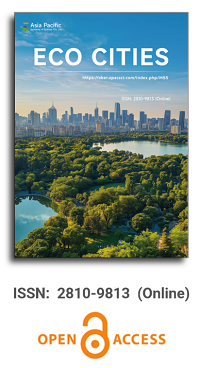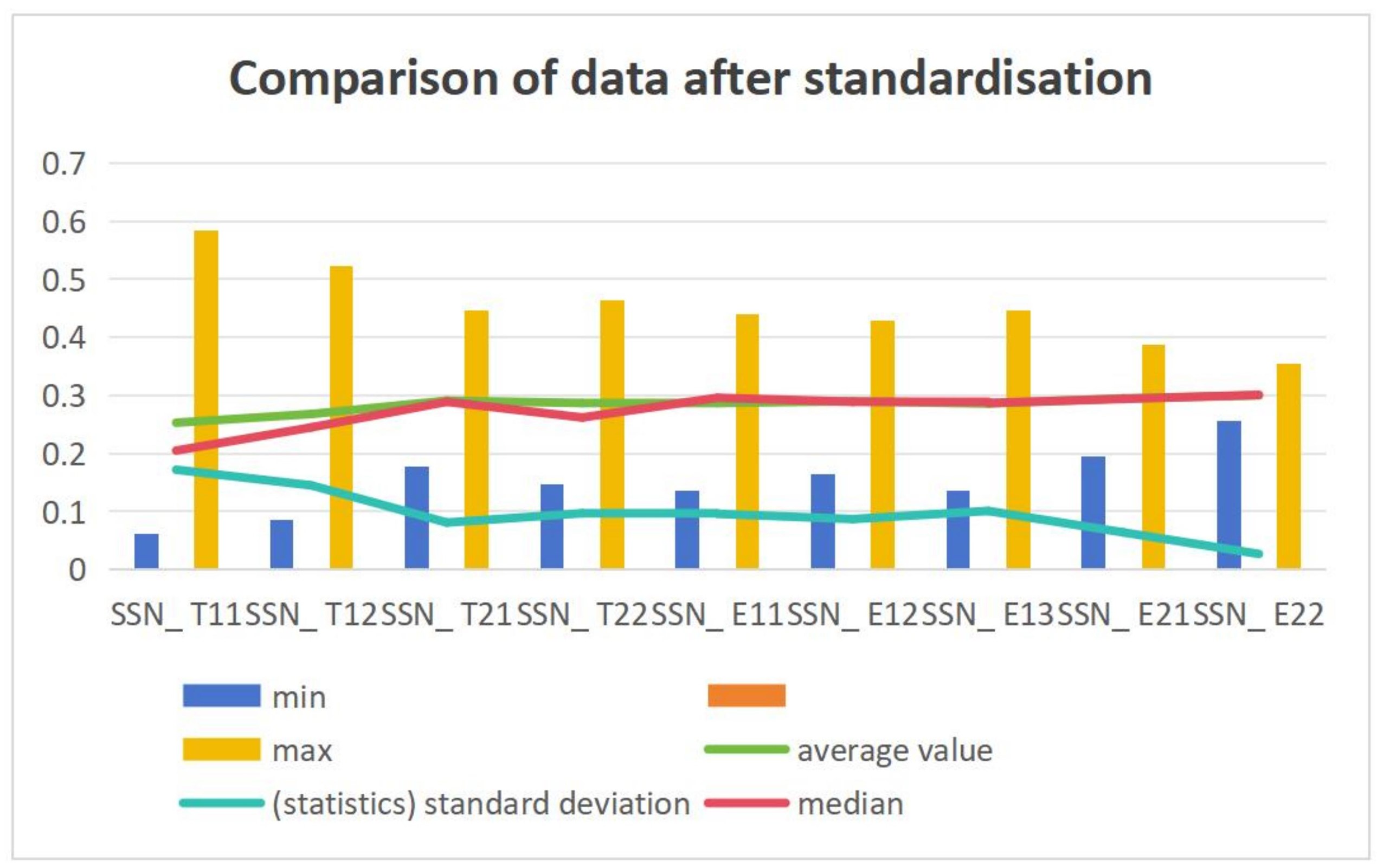


Sustainability, planning and urban development: Seek key integration by studying recent cases
Vol 3, Issue 2, 2022
Download PDF
Abstract
Objective: The application of sustainable development in urban planning and development is a key issue in the management and practice of urbanization in academic and professional circles. Although its importance has been recognized separately, there is now a need for an integrated discussion on planning, urban development, and sustainability. The purpose is to clarify their meaning and explore their compatibility space and limitations, which increases knowledge in this field. Methodology: Through the systematic study of specific literature, this paper makes a critical study of the recent cases of the interaction of these terms, focusing on the diversity of their methods and materials. The complexity of achieving sustainable urban planning and development is emphasized and discussed. Result: The results show that people are more and more interested in the research in this field. Cities can be one of the most advantageous areas for addressing ecological issues through strategic, multi-scale, innovative, visionary, and educational planning, derived from participatory processes, assessed by indicators, and agreed upon by stakeholders at all levels. Originality: In order to clarify these mechanisms, suggestions for further research are also put forward.
Keywords
References
- Harvey D. The right to the city. New left review (2008). 6th ed. In: Legates RT, Stout F (editors). The city readers. London and New York: Routledge; 2016. p. 270–278.
- Harvey D. Rebel cities: From the right to the city to the urban revolution. London, New York: Verso; 2013. p. 187.
- Koolhaas R. Advancement versus apocalypse. In: Mostafawi M, Doherty G (editors). Ecological urbanism. Cambridge (Massachusetts): Harvard Graduate School of Design; 2010. p. 56–71.
- Hanlon B. Review of the book: Social sustainability in urban areas. Journal of Planning Education and Research 2010; 30(2): 213–214.
- Shen L, Ochoa JJ, Shah MN, et al. The application of urban sustainability indicators—A comparison between various practices. Habitat International 2011; 35: 17–29.
- Lewis R. Review of the book: Taking Sustainable Cities Seriously: Economic Development, the Environment and Quality of Life in American Cities. Journal of the American Planning Association 2013; 79(3): 257–258.
- Beatley T, Manning K. The ecology of place: Planning for environment, economy and community. Washington, D.C.: Island Press; 1997. p. 278.
- Berke PR, Conroy MM. Are we planning for sustainable development? An evaluation of 30 comprehensive plans. Journal of the American Planning Association 2000; 66: 21–33.
- Sklarew J. Review of the book: The Post Carbon Reader: Managing the 21st Century’s Sustainability Crisis. Journal of Planning Education and Research 2012; 32(3): 370–372.
- United Nations. Report of the secretary-general on the work of the organization. New York, United Nations; 2015. p. 82.
- Carbonell A. A review of “Planning for Climate Change: Strategies for Mitigation and Adaption for Spatial Planners”. Journal of the American Planning Association 2010; 76(4): 519–520.
- Zheng H, Shen G, Wang H. A review of recent studies on sustainable urban renewal. Habitat International 2014; 41: 272–279.
- Singh RK, Murty HR, Gupta SK, et al. An overview of sustainability assessment methodologies. Ecological Indicators 2012; 15: 281–299.
- Kawakami M, Shen Z, Pai J, et al. Spatial planning and sustainable development. Approaches for achieving sustainable urban form in Asian cities. Dordrecht, Heidelberg, London, New York: Springer; 2013. p. 459.
- Hassan A, Lee H. Toward the sustainable development of urban areas: An overview of global trends in trials and policies. Land Use Policy 2015; 48: 199–212.
- Schubert A, Lang I. The literature aftermath of the Brundtland report ‘Our Common Future’. A scientometric study based on citations in science and social science journals. Environment, Development and Sustainability 2005; 7(1): 1–8.
- Quental N, Lourenço JM. References, authors, journals and scientific disciplines underlying the sustainable development literature: A citation analysis. Scientometrics 2012; 90: 361–381.
- Wheeler S. Sustainable urban development: A literature review and analysis. UC Berkeley, IURD Monograph Series; 1996. p. 138.
- Yang D, Yin C, Long Y. Urbanization and sustainability in China: An analysis based on the urbanization Kuznets-curve. Planning Theory 2013; 12(4): 391–405.
- Van Leeuwen E. Review of the book: Parallel Patterns of Shrinking Cities and Urban Growth: Spatial Planning for Sustainable Development of City Regions and Rural Areas. Journal of Regional Science 2014; 54(3): 538–539.
- Lubell M, Feiock R, Handy S. City adoption of environmentally sustainable policies in California’s central valley. Journal of the American Planning Association 2009; 75(3): 293–308.
- Holden M. Public participation and local sustainability: Questioning a common agenda in urban governance. International Journal of Urban and Regional Research 2011; 35(2): 312–329.
- Larsen K, Gunnarsson-Östling U. Climate change scenarios and citizen-participation: Mitigation and adaptation perspectives in constructing sustainable futures. Habitat International 2009; 33: 260–266.
- Mack EA. Review of the book: Sustainability in America’s Cities: Creating the Green Metropolis. Journal of Planning Literature 2012; 27(4): 461–462.
- United Nations. Informe de la Cumbre Mundial sobre Desarrollo Sostenible (Spanish) [Report of the World Summit on Sustainable Development]; 2002 Aug 26–Sept 4; Johannesburg (South Africa). New York: United Nations; 2002. p. 184.
- Campbell S. Green cities, growing cities, just cities? Urban planning and the contradictions of sustainable development. Journal of the American Planning Association 1996; 62(3): 296–312.
- Bassett SD. Review of the book: Water and the City: Risk, Resilience and Planning for a Sustainable Future. Journal of Planning Education and Research 2013; 33(4): 502–503.
- Hovey B. Review of the book: Governing for Sustainable Urban Development. Journal of Planning Education and Research 2014; 34(2): 244–246.
- Priemus H, Davoudi S. Introduction to the special issue. European Planning Studies 2012; 20(1): 1–6.
- Keil R. Review of the book: Bird on Fire: Lessons from the World’s Least Sustainable City. International Journal of Urban and Regional Research 2014; 38(3): 1127–1128.
- Basiri M, Azim AZ, Farrokhi M. Smart city solution for sustainable urban development. European Journal of Sustainable Development 2017; 6(1): 71–84.
- Conke L, Ferreira T. Urban metabolism: Measuring the city’s contribution to sustainable development. Environmental Pollution 2015; 202: 146–152.
- Daniels TL. A trail across time: American environmental planning from city beautiful to sustainability. Journal of the American Planning Association 2009; 75(2): 178–192.
- Millard-Ball A. The limits to planning: Causal impacts of city climate action plans. Journal of Planning Education and Research 2013; 33(1): 5–19.
- Dymén C, Langlais R. Adapting to climate change in Swedish planning practice. Journal of Planning Education and Research 2013; 33(1): 108–119.
- Theurillat T, Crevoisier O. The sustainability of a financialized urban megaproject: The case of Sihlcity in Zurich. International Journal of Urban and Regional Research 2013; 37(6): 2052–2073.
- Botchwey ND, Trowbridge N, Fisher T. Green health: Urban planning and the development of healthy and sustainable neighborhoods and schools. Journal of Planning Education and Research 2014; 34(2): 113–122.
- Bassett E, Shandas V. Innovation and climate action planning. Perspectives from municipal plans. Journal of the American Planning Association 2010; 76(4): 435–450.
- Roy M. Planning for sustainable urbanisation in fast growing cities: Mitigation and adaptation issues addressed in Dhaka, Bangladesh. Habitat International 2009; 33: 276–286.
- Kärrholm M. The scaling of sustainable urban form: A case of scale-related issues and sustainable planning in Malmö, Sweden. European Planning Studies 2011; 19(1): 97–112.
- Seltzer E. Review of the book: Regional Planning for a Sustainable America: How Creative Programs Are Promoting Prosperity and Saving the Environment. Journal of the American Planning Association 2012; 78(4): 489.
- Marcucci DJ. Review of the book: Regional Planning for a Sustainable America: How Creative Programs Are Promoting Prosperity and Saving the Environment. Journal of Regional Science 2012; 52(3): 525–527.
- Zanon B. Planning small regions in a larger Europe: Spatial planning as a learning process for sustainable local development. European Planning Studies 2010; 18(12): 2049–2072.
- Bihari M. Book review: The purpose of planning: Creating sustainable towns and cities. Journal of Planning Education and Research 2012; 32(3): 372–374.
- Naess P. Urban form, sustainability and health: The case of Greater Oslo. European Planning Studies 2014; 22(7): 1524–1543.
- Dempsey N, Brown C, Bramley G. The key to sustainable urban development in UK cities? The influence of density on social sustainability. Progress in Planning 2012; 77(3): 89–141.
- Sharifi A, Murayama A. Changes in traditional urban form and the social sustainability of contemporary cities: A case study of Iranian cities. Habitat International 2013; 38:126–134.
- Westerink J, Haase D, Bauer A, et al. Dealing with sustainability trade-offs of the compact city in peri-urban planning across European city regions. European Planning Studies 2013; 21(4): 473–497.
- Colaninno N. Sustainable territorial development and urban growth: A critical interaction: The Spanish Mediterranean coast, and Catalonia during the last two decades. ACE: Architecture, City and Environment 2012; 20(7): 149–172.
- Bindzärovä A. Type and size of urban cell as tools for sustainable urban (re)development. Procedia Engineering 2016; 161: 1482–1489.
- Mayer H, Habersetzer A, Meili R. Rural–urban linkages and sustainable regional development: The role of entrepreneurs in linking peripheries and centers. Sustainability 2016; 8(8): 745.
- Echenique MH. A sustainable city. Is urban form really important? Journal of the American Planning Association 2012; 78(2): 121–137.
- Simpson B. Britain’s new towns: Garden cities to sustainable communities. European Planning Research 2010; 18(5): 861–862.
- Nelson AC. A review of “From Sprawl to Sustainability: Smart Growth, New Urbanism, Green Development, and Renewable Energy (2nd ed)”. Journal of the American Planning Association 2010; 76(4): 516–517.
- Williamson J. Review of the book: Seven Rules for Sustainable Communities: Design Strategies for the Post-Carbon World. Journal of Planning Education and Research 2013; 33(2): 250–252.
- Banai R. Review of the book: Seven Rules for Sustainable Communities-Design Strategies for the Post-Carbon World. Journal of Planning Literature 2011; 26(1): 48–49.
- Zhao P. Sustainable urban expansion and transportation in a growing megacity: The impact of urban sprawl on the mobility of urban fringe in Beijing. Habitat International 2010; 34: 236–243.
- Cho-Yam J. Sustainable urban transport planning and the commuting patterns of poor workers in a historic inner city in Guangzhou, China. Habitat International 2013; 39: 119–127.
- Shen Q, Chen Q, Tang B, et al. System dynamics model of sustainable land use planning and development. Habitat International 2009; 33: 15–25.
- Asfour OS. Towards an effective strategy to cope with housing land scarcity in the Gaza Strip as a sustainable development priority. Habitat International 2012; 36: 295–303.
- Ruggeri D. Review of the book: The Principles of Green Urbanism: Transforming the City for Sustainability. Journal of Planning Education and Research. 2013; 33: 132–134.
- Van Leeuwen E. Review of the book: Parallel Patterns of Shrinking Cities and Urban Growth: Spatial Planning for Sustainable Development of City Regions and Rural Areas. Journal of Regional Science 2014; 54(3): 538–539.
- Leigh NG, Hoelzel NZ. Smart growth’s blind side. Sustainable cities need productive urban industrial land. Journal of the American Planning Association 2012; 78(1): 87–103.
- Carlette F. Book review: Potential for Sustainable Communities: Lessons from Low-Carbon Communities. Journal of Planning Literature 2014; 29(3): 274–275.
- Winston N. Urban regeneration for sustainable development: The role of sustainable housing? European Planning Research 2009; 17(12): 1781–1796.
- Blanco J. Sustainable urban development in Chile: A way to introduce a sustainability rating system for neighboring countries. Journal of Architecture and Planning Research 2016; 33(3): 251–270.
- Lin Y, De Meulder B. A conceptual framework for the strategic urban project approach for the sustainable redevelopment of “villages in the city” in Guangzhou. Habitat International 2012; 36(3): 380–387.
- Mayer H, Knox P. Small town Sustainability: The second is the prospect of modernization. European Planning Research 2010; 18(10): 1545–1565.
- UNESCO. Creative cities network. París, culture sector, division of creativity [Internet]. 2004. Available from: https://en.unesco.org/creative-cities/.
- Ruth M. Review of the book: Taking Sustainable cities Seriously: Economic Development, the Environment and Quality of Life in American Cities. Journal of Regional Science 2014; 53(4): 741–742.
- Kharrazi A, Qin H, Zhang Y. Urban big data and sustainable development goals: Challenges and opportunities. Sustainability 2016; 8(12):1293: 1–6.
- Arfvidsson H, Simon D, Oloko M, et al. Engaging with and measuring informality in the proposed Urban Sustainable Development Goal. African Geographic Review 2017; 36(1): 100–114.
- Jo JH, Golden JS, Shin SW. Incorporating built environment factors into climate change mitigation strategies for Seoul, South Korea: A sustainable urban systems framework. Habitat International 2009; 33: 267–275.
- Conejos S, Langston C, Smith J. Adapt STAR model: A climate-friendly strategy to promote built environment sustainability. Habitat International 2013; 37: 95–103.
- Cerón-Palma I, Sanye-Mengual E, Montero J, et al. Towards a green sustainable strategy for social neighbourhoods in Latin America: Case from social housing in Merida, Yucatan, Mexico. Habitat International 2013; 38: 47–56.
- Abdel Galil R. Desert reclamation, management system for sustainable urban expansion. Planning Progress 2012; 78(4): 151–206.
- Anderson K, Angelstam P, Axelsson R, et al. Connecting urban and regional planning: Analysis and visualization of sustainability indicators in Bergerslagen, Sweden. European Planning Research 2013; 21(8): 1210–1234.
- Simon D, Arfvidsson H, Anand G, et al. Developing and testing the urban sustainable development goal’s targets and indicators, a five-city study. Environment and Urbanization 2016; 28(1): 49–63.
- Bügl R. Identifying stakeholders’ views on sustainable urban transition: Desirability, utility and probability assessments of scenarios. European Planning Studies 2012; 20(10): 1667–1687.
- Restrepo CE. Review the book: Ecopolis: Architecture and Cities for a Changing Climate. Journal of the American Planning Association 2010; 76(1): 128–129.
- Curtis C, Scheurer J. Planning for sustainable accessibility: Developing tools to aid discussion and decision-making. Planning Progress 2010; 74: 53–106.
- Akkar M. Challenges and conflicts in achieving sustainable communities in Istanbul’s historic districts. Habitat International 2011; 35(2): 295–306.
- Garde A. Sustainable by design? Insights from U.S. LEED-ND Pilot Projects. Journal of the American Planning Association 2009; 75(4): 424–440.
- Schmidt S. Review of the book: Growing Greener Cities: Urban Sustainability in the Twenty First Century. Journal of the American Planning Association 2010; 76(3): 381.
- Calthorpe P. The next American metropolis. Ecology, community and the American dream. New York: Princeton Architecture Press; 1993. p. 176.
- Duany A, Plate-Zyberk E. Towns and town-making principles. New York: Rizzoli; 1991. p. 119.
- Mostafavi M, Doherty G. Urbanismo ecológico. Volumen 1: ¿Por qué urbanismo ecológico? ¿Por qué ahora? (Spanish) [Ecological urbanism. Volume 1: Why ecological urbanism? Why now?]. Barcelona: Gustavo Gigli; 2014. p. 655.
- Jabareen YR. Sustainable urban form. Their types, models and concepts. Journal of Planning Education and Research 2006; 26(1): 38–52.
- Jacobs J. The death and life of great American cities. New York: Penguin Random House; 1961. p. 472.
- Paterson M. Global warming and global politics. London: Routledge; 1996. p. 256.
- Giddens A. The politics of climate change. Cambridge: Political Press; 2009. p. 276.
- Krueger R, Buckingham S. Towards a ‘consensual’ urban politics? Creative planning, urban sustainability and regional development. International Journal of Urban and Regional Studies 2012; 36(3): 486–503.
- Scoppetta C. Broadening the public sphere through creative shadow planning. ACE: Architecture, City and Environment 2013; 21(7): 67–96.
- Redclift M. Sustainable development: Explore contradictions. London: Routledge; 1987. p. 230.
- Visvanathan S. Mrs Brundtland’s disenchanted cosmos. Alternative 1991; 16(3): 377–384.
- Beck U. Risk society: Towards a new modernity. London: Sage Publications; 1992. p. 272.
- Escobar A. Construction natures: Elements for a post-structuralism political ecology. Futures 1996; 28(4): 325–343.
- Swyngedouw E. Nature does not exist! Sustainability as symptom of a depoliticized planning. Urban 2011; (1): 41–66.
- Latour B. Politics of nature: How to bring the sciences into democracy. Cambridge, Massachusetts: Harvard University Press; 2004. p. 320.
- Innerarity D. Justicia climática (Spanish) [Climate justice]. Dilemata, Revista Internacional de Éticas Aplicadas 2012; 9: 175–191.
- Davis M. Planet of slums. London: VISO; 2006. p. 256.
- Brenner NY, Schmid C. The urban age in question. International Journal of Urban and Regional Studies 2013; 38(3): 1–25.
Supporting Agencies
Copyright (c) 2022 Francisco Sergio Campos-Sánchez, Francisco Javier Abarca-Álvarez, Alvaro Domingues
License URL: https://creativecommons.org/licenses/by/4.0

This site is licensed under a Creative Commons Attribution 4.0 International License (CC BY 4.0).

Chinese Academy of Sciences, China
Indexing & Archiving
Asia Pacific Academy of Science Pte. Ltd. (APACSCI) specializes in international journal publishing. APACSCI adopts the open access publishing model and provides an important communication bridge for academic groups whose interest fields include engineering, technology, medicine, computer, mathematics, agriculture and forestry, and environment.



.jpg)

.jpg)



